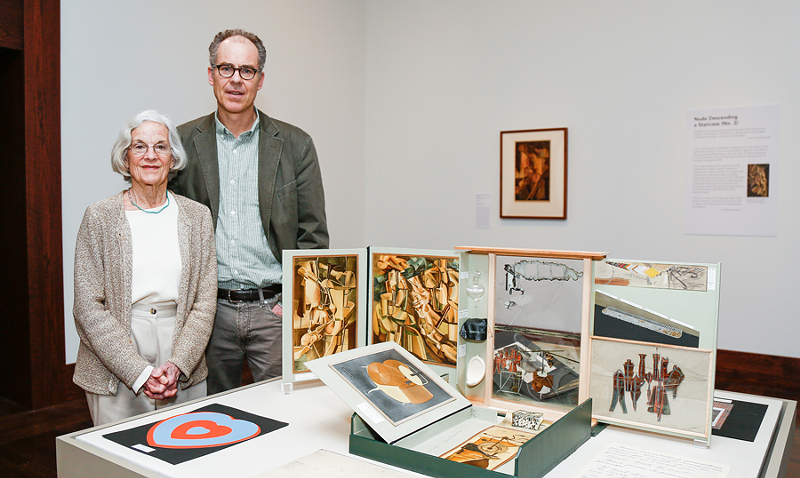What a surprise it is to find that a gallery in the Cincinnati Art Museum is newly devoted to Marcel Duchamp. Not that this French-born artist, who spent much time in New York and died in 1968, doesn’t deserve it — he’s often ranked, along with Picasso and Matisse, as one of the three greatest 20th-century artists. But until very recently, the Cincinnati Art Museum hasn’t owned enough by Duchamp to merit an exclusive gallery. (It has a color etching from 1964, “Mirrorical Return.”)
However, a gift the museum received at the end of 2016 is now being celebrated with the current gallery show Marcel Duchamp: Boîte-en-Valise. Even more surprisingly, the museum only received the object because of its strong Cincinnati connection.
Around 1964, Duchamp himself gave “Boîte-en-Valise (Box in a Valise),” a kind of portable museum consisting of miniature reproductions of his pre-World War II work, to Agnes and Carl Harrison, who lived on a farm in Clermont County. (Carl's full name Charles Learner Harrison Jr.)
Agnes, whose Cincinnati family’s name was Sattler, was the older sister of Alexina (“Teeny”), who had married Duchamp in 1954 after first being married to Pierre Matisse, an art dealer and son of Henri Matisse. She was familiar with the art world of Europe and New York and lived in New Jersey when she met Duchamp.
“Aggie (Agnes) got to study in Paris in her later teens and was able to convince her parents to let Teeny come,” says Jeffrey Harrison, who helped his mother (and Agnes’ daughter-in-law) Anne W. Harrison donate the family’s “Boîte” to the museum after her husband, Robert Sattler Harrison, died in 2012 and she moved from the farm. “Aggie stayed in Cincinnati, lived in the country, led a pretty quiet life, acquired a piece of art or two. Teeny was off in this other world. But they did stay close.”
Duchamp was a conceptualist who knew how to use visual art to provoke people into thinking about what it means to be creative. Two of his most famous pieces are 1917’s “Fountain,” a purchased urinal that he signed “R. Mutt” and entered into an art show, and his 1919 found-object readymade “L.H.O.O.Q.,” for which he added a mustache and goatee to a postcard reproduction of the “Mona Lisa.”
Duchamp had conceived and assembled the first edition of 20 “Boîtes” (each in an actual leather suitcase) from 1935-41, finishing as pressure grew for him and his art to escape Nazi-occupied France. Afterward, in the 1950s and ’60s, he created six additional series — about 300 total — without the suitcases. Many are in museums.
The “Boîte” he gave to the Harrisons is from 1963’s Series E. It is stunning when you come across it in the art museum now, displayed almost like a sacred text. Prints Curator Kristin Spangenberg has dramatically placed it in the center of the room, under a giant see-through protective cover. Its parts, which slide or fold out from the box, reveal 68 finely rendered miniature replicas, photographs and color reproductions — some on paper, some sculptural — of Duchamp’s own work.
And on the label of one miniature, “Coeurs volants (Fluttering Hearts),” is a personal inscription in French: “To Agnes and Carl grande affection Marcel Duchamp.”
To Anne Collins Goodyear, a Duchamp scholar and co-director of the Bowdoin College Museum of Art, that dedication elevates the importance of this specific “Boîte.” She had come to the art museum last week with the Harrisons to see the Duchamp installation.
“Although we think of him as an extremely cerebral person, something I’ve come to appreciate about him a great deal is that I think he had a very strong affinity for family,” she says. “This particular object provides so much important information about Duchamp, his family and even the role of Cincinnati in how it shaped Teeny and her sister Agnes. It was obvious this box was being well cared-for in the context in which it lived. But it needed to make its way from this family into the public arena.”
Marcel Duchamp: Boîte-en-Valise will only be on display through May 6. More information: cincinnatiartmuseum.org.


